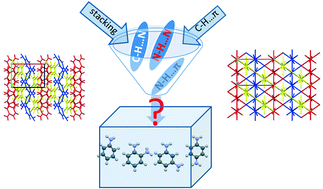Acceptor properties of amino groups in aminobenzene crystals: study from the energetic viewpoint†
Abstract
Acceptor properties of the amino groups of aniline and ortho, meta and para-diaminobenzenes in the crystal phase have been studied through the analysis of their crystal structures based on comparison of interaction energies in a crystal. Analysis of pairwise interaction energies allowed recognition of the basic structural motifs (BSMs) and determination of the types of hydrogen bonds which cause the bonding of the molecules within the BSMs and between neighboring ones. The N–H⋯N hydrogen bonds where the nitrogen lone pair is a proton acceptor were shown to be present in all studied crystals and played different roles in crystal packing. The N–H⋯N hydrogen bonds form the building unit and the primary structural motif in two polymorphic modifications of ortho-diaminobenzene. In the crystal of meta-diaminobenzene, the N–H⋯N interaction's role is comparable with that of the N–H⋯π hydrogen bonds. Both these interactions form the primary basic structural motifs. Finally, the N–H⋯N hydrogen bonds have a minor role in the crystals of aniline and para-diaminobenzene where these interactions ensure bonding between secondary basic structural motifs. The crystals of the monoclinic and orthorhombic polymorphs of aniline as well as para-diaminobenzene differ from each other by mutual arrangement of the secondary basic structural motifs.



 Please wait while we load your content...
Please wait while we load your content...